As I’ve pondered the American reaction to the death of Osama Bin Laden, I’ve been trying to decide what word would characterize my reaction. Rejoicing isn’t right. Happy isn’t right. Celebrating isn’t right. Glad. Gratified. Grateful…none of these are exactly what pinpoints what the reaction ought to be because of this:
Like it or not, Bin Laden was made in the image of God.
That’s what the Bible says.
Then God said, “Let us make man in our image, in our likeness, and let them rule over the fish of the sea and the birds of the air, over the livestock, over all the earth, and over all the creatures that move along the ground.” (Genesis 1:26)
Isn’t it interesting that before God ever made you, He had in mind that you would bear His image?
- Before His hands picked up the dust and formed you?
- Before He breathed life into you?
Before you were born, He created you—and all the rest of mankind—to bear His image.
For us to rejoice in the death of Bin Laden is for us—in a strange way—to rejoice over the destruction of the image of God in another person. Make no mistake: Bin Laden was destructive, dangerous, and had nothing but contempt for his fellow human beings. His actions were wicked, evil, horrific, reprehensible, and brought deep sorrow to thousands of innocent people. Yet, under all Bin Laden’s sin, the image of God was there because he was human and God had created him.
For that reason, we cannot trivialize death of any human being, even in light of Jesus’ mission of destroying the devil’s work. Jesus destroyed the devil’s work by the power of His love and grace.
Issues like how a Christian should respond to the death of Bin Laden should not divide Christians from one another. We can be satisfied that God used human agency to accomplish His justice. We can honor the bravery of the Navy SEALs and the careful planning. We can be grateful that peace among men has one less enemy today. We can praise God that God alone is righteous and that His grace saves sinners—just like us—who repent. We can ask for hearts that can somehow love our enemies.
We can do these things by remembering that we were CREATED TO BE…God’s Image Bearers.
1 John 3:5 But you know that he appeared so that he might take away our sins. And in him is no sin. 6 No one who lives in him keeps on sinning. No one who continues to sin has either seen him or known him. 7 Dear children, do not let anyone lead you astray. He who does what is right is righteous, just as he is righteous. 8 He who does what is sinful is of the devil, because the devil has been sinning from the beginning. The reason the Son of God appeared was to destroy the devil’s work. 9 No one who is born of God will continue to sin, because God’s seed remains in him; he cannot go on sinning, because he has been born of God. 10 This is how we know who the children of God are and who the children of the devil are: Anyone who does not do what is right is not a child of God; nor is anyone who does not love his brother. 11 This is the message you heard from the beginning: We should love one another. 12 Do not be like Cain, who belonged to the evil one and murdered his brother. And why did he murder him? Because his own actions were evil and his brother’s were righteous.
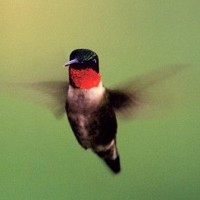 Part of the joy of gardening is the beauty of wildlife drawn to a well planned garden. I love birds. When I was a child, I kept a bird-watching journal and enjoyed identifying birds and their habitats. A long time ago, I abandoned the written journal, but mentally, I have a record of birds in the yard and when their seasons are.
Part of the joy of gardening is the beauty of wildlife drawn to a well planned garden. I love birds. When I was a child, I kept a bird-watching journal and enjoyed identifying birds and their habitats. A long time ago, I abandoned the written journal, but mentally, I have a record of birds in the yard and when their seasons are.
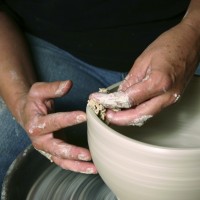
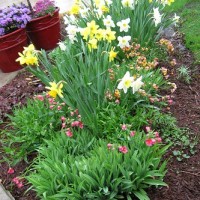 Real world gardening involves everything being beautiful its time (Ecclesiastes 3:11).
Real world gardening involves everything being beautiful its time (Ecclesiastes 3:11). 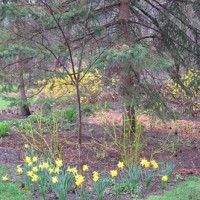 Even in the midst of dreary days, perennial features such as the cheerful yellow forsythia, “Cardinal” red-twig dogwood, and King Alfred daffodils lift one’s spirits.
Even in the midst of dreary days, perennial features such as the cheerful yellow forsythia, “Cardinal” red-twig dogwood, and King Alfred daffodils lift one’s spirits.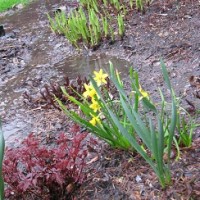 And look at the beautiful range of colors of emerging growth of turtlehead (Chelone obliqua), Astilbe ‘Fanal’, and hostas—all of which tolerate standing water for short periods. Good thing, since in every real world garden a little rain must fall. This particular garden is always among the last to be worked because it is a low spot in our yard. I find that working our higher front yard to the lowest back is always helpful since that’s how things aren’t worked when it’s too wet. Working the soil when it’s wet ruins the structure. Mulching when it’s raining causes the ground to retain the soggy conditions longer. It’s important with conditions like these to research carefully what plants will survive in such Out of Eden locations.
And look at the beautiful range of colors of emerging growth of turtlehead (Chelone obliqua), Astilbe ‘Fanal’, and hostas—all of which tolerate standing water for short periods. Good thing, since in every real world garden a little rain must fall. This particular garden is always among the last to be worked because it is a low spot in our yard. I find that working our higher front yard to the lowest back is always helpful since that’s how things aren’t worked when it’s too wet. Working the soil when it’s wet ruins the structure. Mulching when it’s raining causes the ground to retain the soggy conditions longer. It’s important with conditions like these to research carefully what plants will survive in such Out of Eden locations.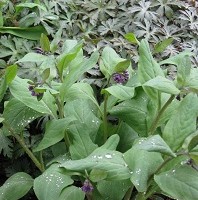 My bluebells (Mertensia virginica) are budding and my native cranesbill geranium (Geranium maculatum) won’t be outdone. Also in my woodland garden are lily-of-the-valley (Convallaria majalis) and sweet woodruff (Galium odoratum) which are not native but escaped cultivation and are real showstoppers. I like that phrase: escaped cultivation. Makes them seem like garden rebels…or too beautiful to be held captive.
My bluebells (Mertensia virginica) are budding and my native cranesbill geranium (Geranium maculatum) won’t be outdone. Also in my woodland garden are lily-of-the-valley (Convallaria majalis) and sweet woodruff (Galium odoratum) which are not native but escaped cultivation and are real showstoppers. I like that phrase: escaped cultivation. Makes them seem like garden rebels…or too beautiful to be held captive. O’Reilly, this means you. While in the camera’s eye, you have the ability to persuade many people and convince them that “the spin stops here.” When you enter the realm of theology, we no longer call it spin. To the extent you are misinformed and try to play pastor-prophet-priest in your bully pulpit, you need to know the consequences of displaying such ignorance: it’s called deception. Lies. Dangerous. Infectious.
O’Reilly, this means you. While in the camera’s eye, you have the ability to persuade many people and convince them that “the spin stops here.” When you enter the realm of theology, we no longer call it spin. To the extent you are misinformed and try to play pastor-prophet-priest in your bully pulpit, you need to know the consequences of displaying such ignorance: it’s called deception. Lies. Dangerous. Infectious. Top Ten Things I Wish Every Jew Knew About Christians (Summary Version)
Top Ten Things I Wish Every Jew Knew About Christians (Summary Version) With the tomb empty—as Jesus foretold—the sacrifice was accepted. Forgiveness of our sins was made possible, once for all. Now what is left for us is to give thanks to the Lord, saying “He is good; his love endures forever.” To kneel before our Maker in humble worship. To know that He is God in heaven and that the Risen Christ is God’s glory revealed.
With the tomb empty—as Jesus foretold—the sacrifice was accepted. Forgiveness of our sins was made possible, once for all. Now what is left for us is to give thanks to the Lord, saying “He is good; his love endures forever.” To kneel before our Maker in humble worship. To know that He is God in heaven and that the Risen Christ is God’s glory revealed.
 The encouragement that we get from this is that there is nothing we can do to save ourselves. There is nothing we can do to right our wrongs. There is nothing we can do about our imperfections. There is no way we can be perfectly obedient. There is no way we’ll resist every temptation. There is no way that we will speak truthfully all the time no matter how hard we try. And there is no opposition we will face that compares to what Jesus experienced. For us, it is impossible to lay our lives down for our fellow man as Jesus did. So we can stand with hearts of gratitude knowing it is for our benefit that Jesus did it all and could say, “It is finished.” It was all for our benefit. Now what remains is for us to recieve the gift of grace that He made possible by finishing the work of God.
The encouragement that we get from this is that there is nothing we can do to save ourselves. There is nothing we can do to right our wrongs. There is nothing we can do about our imperfections. There is no way we can be perfectly obedient. There is no way we’ll resist every temptation. There is no way that we will speak truthfully all the time no matter how hard we try. And there is no opposition we will face that compares to what Jesus experienced. For us, it is impossible to lay our lives down for our fellow man as Jesus did. So we can stand with hearts of gratitude knowing it is for our benefit that Jesus did it all and could say, “It is finished.” It was all for our benefit. Now what remains is for us to recieve the gift of grace that He made possible by finishing the work of God. One of the common human sensations is thirst. When Jesus quotes Psalm 69:21 as being fulfilled, there is a sense that He was reassuring us of His humanity. He was identifying with our humanity through a very human need: thirst.
One of the common human sensations is thirst. When Jesus quotes Psalm 69:21 as being fulfilled, there is a sense that He was reassuring us of His humanity. He was identifying with our humanity through a very human need: thirst.